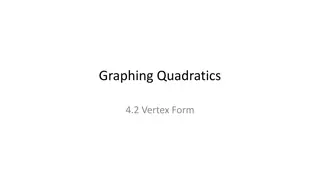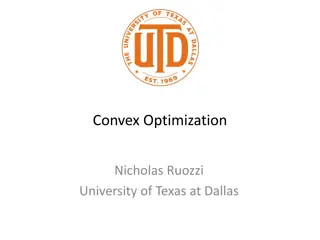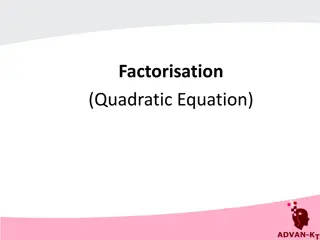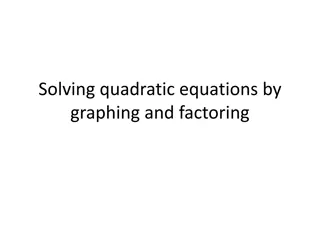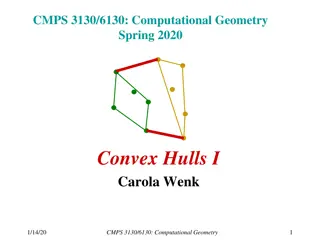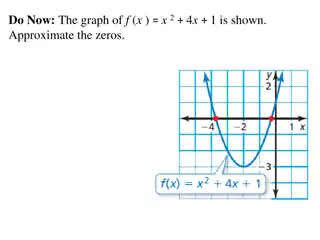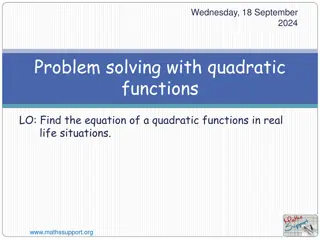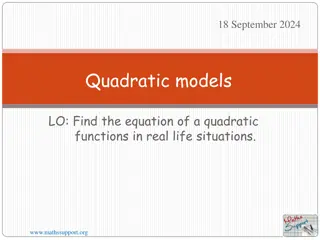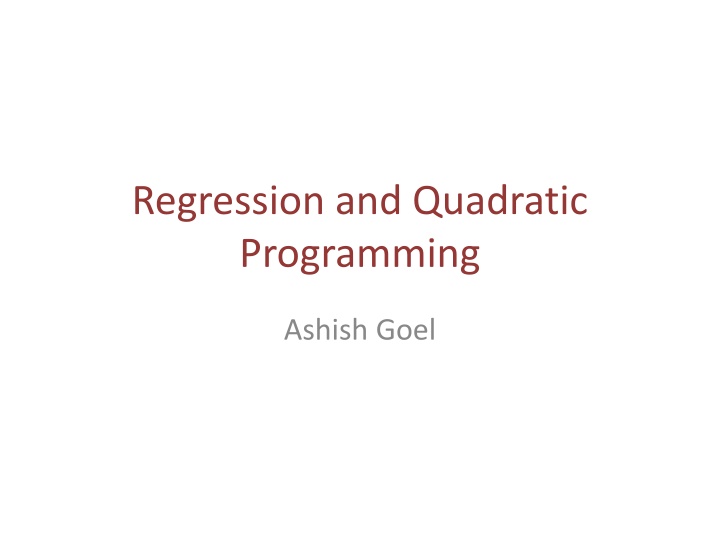
Introduction to Linear Regression and Quadratic Programming
Learn about Linear Regression in machine learning, where models are built based on data to predict outcomes. Explore how to find the best linear estimator using Least Squares Regression and Absolute Error Regression techniques. Dive into Quadratic Programming concepts for optimization tasks.
Download Presentation

Please find below an Image/Link to download the presentation.
The content on the website is provided AS IS for your information and personal use only. It may not be sold, licensed, or shared on other websites without obtaining consent from the author. If you encounter any issues during the download, it is possible that the publisher has removed the file from their server.
You are allowed to download the files provided on this website for personal or commercial use, subject to the condition that they are used lawfully. All files are the property of their respective owners.
The content on the website is provided AS IS for your information and personal use only. It may not be sold, licensed, or shared on other websites without obtaining consent from the author.
E N D
Presentation Transcript
Regression and Quadratic Programming Ashish Goel
Linear Regression Given a set of K data points, where each data point has d features xiand an outcome yi Note that xiis a d-dimensional vector whereas yiis a scalar Goal: make a model based on data that can be used to estimate/predict the values of the outcome variable for other data points where you know the features but not the outcome Example: Predict risk of breast cancer or prostate cancer in the next five years given height, weight, age, race, family history, and blood test results Lots of data points from patients who underwent the same tests 5 or more years ago Another simple example: predicting stride length (last class)
Linear Regression Let f be an unknown real-valued function defined on points in d dimensions. We are given the value of f on K points, x1, x2, , xK, where each xiis d 1 f(xi) = yi Goal: Find the best linear estimator of f Linear estimator: Approximate f(x) as xTp + q p and q are decision variables, (p is d 1, q is scalar) p is often known as the coefficients, and q as the intercept/shift Error of the linear estimator for xiis denoted i i= (xi)Tp + q - yi
Linear Regression Best linear estimator: one which minimizes the error Individual error for xi: i Overall error: Multiple formulas; one commonly used formula is the sum of the squares of the individual errors
Linear Least Squares Regression Minimize i( i)2 s.t. For all i in {1..K}: i= (xi)Tp + q - yi
Absolute Error Regression Minimize i| i| s.t. For all i in {1..K}: i= (xi)Tp + q - yi
Absolute Error Regression Equivalent to minimizing L1 norm Minimize || ||1 s.t. For all i in {1..K}: i= (xi)Tp + q - yi
Linear Regression [contd] In class, we saw how to solve both versions of these using excel for a simple example. For the L1 norm, we reduced it to a LP by using auxiliary variables. For the square error, we solved it using a non-linear solver, but we have no idea why it works for this quadratic objective This class and next: We will first see how to solve these using python, so we can get a head start on the HW We will discuss regularization and overfitting We will see (with a certain amount of formalism) a general case of quadratic objectives We will see (with a wave of the hand) why we can just use the L1 norm formulation in the objective function without auxiliary variables
Folding in the intercept Minimize i( i)2 s.t. For all i in {1..K}: i= (xi)Tp + q - yi Can simplify this further. Let X denote the d K matrix obtained from all the xi s: X = (x1x2 xK)
Folding in the intercept QP: Minimize i( i)2 s.t. For all i in {1..K}: i= (xi)Tp + q - yi Can simplify this further. Let X denote the d K matrix obtained from all the xi s: X = (x1x2 xK) Let e denote a K 1 vector of all 1 s
Folding in the intercept QP: Minimize T (or || ||1) s.t. = XTp + qe y But now we can just add the column e to X and pretend that we have just one (d+1)- dimensional variable p
Overfitting and Regularization in One Slide Overfitting: The number of features is so large that you can get good performance on the training set but the model is not generalizable to the test set or in deployment You can detect overfitting, e.g. if model performance on the training set is much better than on the test set. But how do you fix it? Often, using regularization. Key idea: You may have many features, but you don t want to use all of them heavily. So add a penalty term for too heavy a use of the features Intuition: Promotes models that are frugal in their use of the features, and hence more likely to generalize beyond the training set Example: Minimize || ||1+ ||p||1 s.t. For all i in {1..K}: i= (xi)Tp + q yi Here, the parameter controls the regularization strength, and means that we are minimizing the L1 norm of the coefficients, encouraging us to use smaller values for coefficients. Can use the sum of the squares of the coefficients if we so choose. These are important enough that they have their own names: Ridge regression: uses sum of squares for normalization Lasso regression: uses L1 norm for regularization This general idea can be used for many other ML algorithms
A simple quadratic program Minimize (x1)2 Subject to: -x1+ x2 3 -x1 x2 -2
A simple quadratic program Minimize (x1)2 Subject to: -x1+ x2 3 -x1 x2 -2 MOST OPTIMIZATION SOFTWARE HAS A QUADRATIC OR CONVEX OR NON-LINEAR SOLVER THAT CAN BE USED TO SOLVE MATHEMATICAL PROGRAMS WITH LINEAR CONSTRAINTS AND A MIN-QUADRATIC OBJECTIVE FUNCTION EASY IN PRACTICE
A simple quadratic program Minimize (x1)2 Subject to: -x1 + x2 3 -x1 x2 -2 MOST OPTIMIZATION SOFTWARE HAS A QUADRATIC OR CONVEX OR NON-LINEAR SOLVER THAT CAN BE USED TO SOLVE MATHEMATICAL PROGRAMS WITH LINEAR CONSTRAINTS AND A MIN-QUADRATIC OBJECTIVE FUNCTION EASY IN PRACTICE QUADRATIC PROGRAM
Next Steps Why are Quadratic programs (QPs) easy? Formal Definition of QPs Examples of QPs
Next Steps Why are Quadratic programs (QPs) easy? Intuition; not formal proof Formal Definition of QPs Examples of QPs Regression and Portfolio Optimization
Approximating the Quadratic Approximate x2 by a set of tangent lines (here x is a scalar, corresponding to x1 in the previous slides) d(x2)/dx = 2x, so the tangent line at (a, a2) is given by y a2 = 2a (x-a) or y = 2ax a2 The upper envelope of the tangent lines gets closer and closer to the real curve
APPROXIMATING THE QUADRATIC 7 y = x*x 6 5 4 3 2 1 0 -1 -2 -1.5 -1 -0.5 0 0.5 1 1.5 2
APPROXIMATING THE QUADRATIC 7 y = x*x y1 = 0 6 5 4 3 2 1 0 -1 -2 -1.5 -1 -0.5 0 0.5 1 1.5 2
APPROXIMATING THE QUADRATIC 7 y = x*x y1 = 0 y2 = 2x -1 y3 = -2x-1 6 5 4 3 2 1 0 -1 -2 -1.5 -1 -0.5 0 0.5 1 1.5 2
APPROXIMATING THE QUADRATIC 7 y = x*x y1 = 0 y2 = 2x -1 y3 = -2x-1 y4 = 4x-4 y5 = -4x-4 6 5 4 3 2 1 0 -1 -2 -1.5 -1 -0.5 0 0.5 1 1.5 2
APPROXIMATING THE QUADRATIC 7 y = x*x y1 = 0 y2 = 2x -1 y3 = -2x-1 y4 = 4x-4 y5 = -4x-4 y6 = x - 0.25 y7 = -x -0.25 6 5 4 3 2 1 0 -1 -2 -1.5 -1 -0.5 0 0.5 1 1.5 2
APPROXIMATING THE QUADRATIC 7 y = x*x y1 = 0 y2 = 2x -1 y3 = -2x-1 y4 = 4x-4 y5 = -4x-4 y6 = x - 0.25 y7 = -x -0.25 6 5 4 3 2 1 0 -1 -2 -1.5 -1 -0.5 0 0.5 1 1.5 2
Approximating the Quadratic Minimize Max {y1, y2, y3, y4, y5, y6, y7} Subject to: -x1 + x2 3 -x1 x2 -2 y1 = 0 y2 = 2x1 1 y3 = -2x1 1 y4 = 4x1 4 y5 = -4x1 4 y6 = x1 0.25 y7 = -x1 0.25 Minimize (x1)2 Subject to: -x1 + x2 3 -x1 x2 -2
Approximating the Quadratic Minimize z Subject to: -x1 + x2 3 -x1 x2 -2 z 0 z 2x1 1 z -2x1 1 z 4x1 4 z -4x1 4 z x1 0.25 z -x1 0.25 Minimize (x1)2 Subject to: -x1 + x2 3 -x1 x2 -2
Approximating the Quadratic Minimize z Subject to: -x1 + x2 3 -x1 x2 -2 z 0 z 2x1 1 z -2x1 1 z 4x1 4 z -4x1 4 z x1 0.25 z -x1 0.25 Minimize (x1)2 Subject to: -x1 + x2 3 -x1 x2 -2 LPs can give successively better approximations
Approximating the Quadratic Minimize z Subject to: -x1 + x2 3 -x1 x2 -2 z 0 z 2x1 1 z -2x1 1 z 4x1 4 z -4x1 4 z x1 0.25 z -x1 0.25 Minimize (x1)2 Subject to: -x1 + x2 3 -x1 x2 -2 Quadratic Programs = Linear Programs in the limit
QPs and LPs Is it necessarily true for a QP that if an optimal solution exists and a BFS exists, then an optimal BFS exists?
QPs and LPs Is it necessarily true for a QP that if an optimal solution exists and a BFS exists, then an optimal BFS exists? NO!! Intuition: When we think of a QP as being approximated by a succession of LPs, we have to add many new variables and constraints; the BFS of the new LP may not be the same as the BFS of the feasible region for the original constraints.
QPs and LPs In any QP, it is still true that any local minimum is also a global minimum Is it still true that the average of two feasible solutions is also feasible?
QPs and LPs In any QP, it is still true that any local minimum is also a global minimum Is it still true that the average of two feasible solutions is also feasible? Yes!!
QPs and LPs In any QP, it is still true that any local minimum is also a global minimum Is it still true that the average of two feasible solutions is also feasible? Yes!! QPs still have enough nice structure that they are easy to solve
Formal Definition of a QP Minimize cTx + yTy s.t. Ax = b Ex f Gx h y = Dx Where x, y are decision variables. All vectors are column vectors.
Formal Definition of a QP Minimize cTx + yTy s.t. Ax = b Ex f Gx h y = Dx The quadratic part is always non-negative Where x, y are decision variables. All vectors are column vectors.
Formal Definition of a QP Minimize cTx + yTy s.t. Ax = b Ex f Gx h y = Dx i.e. ANY LINEAR CONSTRAINTS Where x, y are decision variables. All vectors are column vectors.
Equivalently Minimize cTx + (Dx)T(Dx) s.t. Ax = b Ex f Gx h Where x are decision variables. All vectors are column vectors.
Equivalently Minimize cTx + xTDTDx s.t. Ax = b Ex f Gx h Where x are decision variables. All vectors are column vectors.
Equivalently Minimize cTx + xTPx s.t. Ax = b Ex f Gx h P is positive semi-definite (a matrix that can be written as DTD for some D) Where x are decision variables. All vectors are column vectors.
Equivalently Minimize cTx + yTy s.t. Ax = b Ex f Gx h Where x are decision variables, and y represents a subset of the coordinates of x. All vectors are column vectors.
Equivalently Instead of minimizing, the objective function is Maximize cTx xTPx For some positive semi-definite matrix P
Is this a QP? Minimize xy s.t. x + y = 5
Is this a QP? Minimize xy s.t. x + y = 5 No, since x = 1, y=-1 gives xy = -1. Hence xy is not an acceptable quadratic part for the objective function.
Is this a QP? Minimize xy s.t. x + y = 5 x, y 0
Is this a QP? Minimize xy s.t. x + y = 5 x, y 0 No, for the same reason as before!
Is this a QP? Minimize x2 -2xy + y2 - 2x s.t. x + y = 5
Is this a QP? Minimize x2 -2xy + y2 - 2x s.t. x + y = 5 Yes, since we can write the quadratic part as (x- y)(x-y).
Linear Least Squares Regression QP: Minimize i ( i)2 s.t. For all i in {1..K}: i = (xi)Tp + q - yi
Convex programming in One Slide Convex program: where f(x) is a convex function of x. Minimize f(x) subject to Linear constraints in x Convex function: Second derivative is non-negative in every direction Intuition: The same trick of approximating by max of all its tangents works in the limit, hence we expect it to be tractable Computational Theory: Algorithms that work well for LPs can solve reasonable convex programs (second derivative never too small or too large and surface does not have a lot of corners) provided they are gradient-descent style algorithms Optimization Theory: There is a notion very akin to duality (KKT conditions) In practice: General purpose tools like cvxpy and gurobi are very good at solving large classes of convex programs, but custom coding is still often needed Lp norms are Convex (for p >= 1)


